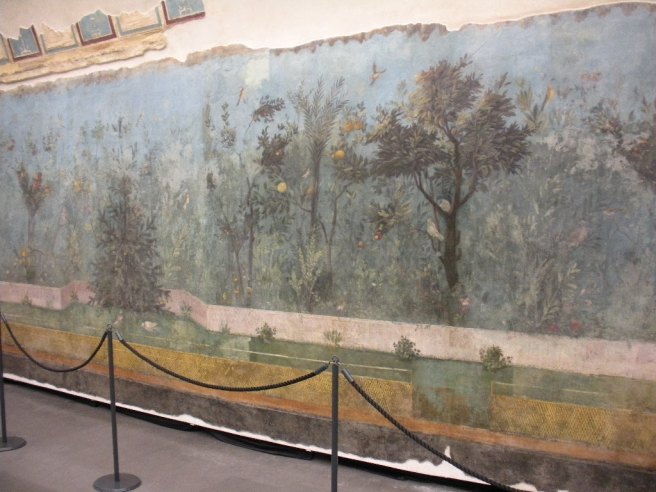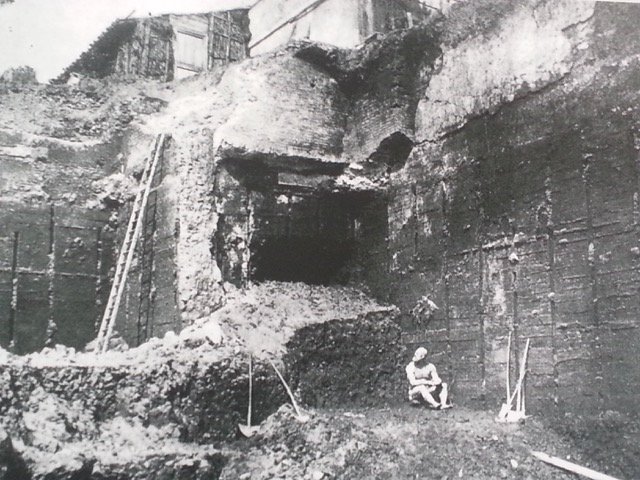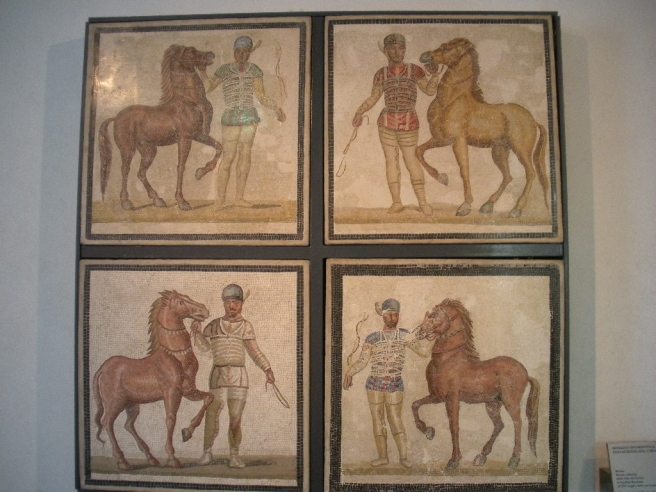
For a lover of Ancient Rome entering this museum is like opening the gates of paradise. Furthermore, of an uncrowded one. As I wrote in the previous post I’m quite fond of peaceful spots and this is one indeed. Palazzo Massimo alle Terme hosts an extraordinary collection of Roman statues, mosaics and frescoes discovered from the XIXth century during works in the city.
The boxer
My favourite statue is “the boxer”, a greek bronze from the IV century B.C., probably work of Lisipo, and discovered in the Quirinal Hill when excavating the Therms of Constantine.
In this close-up you can see the details (check out this vid for more close-ups) with which the artist has portrayed the fighter. The wounds (the blood is represented using copper) in his face, the swollen eyes, the broken lip, the mashed ears. The athlete is resting, it is not the usual image of victory; maybe he’s gathering his strength to continue the fight, or has been defeated and turns to an unknown referee, waiting for mercy or the victory veredict. Waiting, as the statue had for hundreds of years. This picture, taken when the statue was discovered in the XIXth century, touches me deeply.
Livia’s triclinium
In the third floor of the museum you can see the frescoes and mosaics that decorated the rooms in some patrician villas. My favourite place is the reconstruction of the “summer dinner room” in the Villa of Livia Drusilla, wife of the first Roman Emperor, Augustus.
The villa was in the Flaminian road, ad gallinas albas (“where the white chickens”). When Livia married Octavian, a prodigy occurred. An eagle dropped a white chicken in her lap; the bird had a twig of laurel with berries in its beak. Following the soothsayers advice, the chicken and its offspring were raised in the villa, and a forest of laurel oaks was planted around its perimetre. The leaves of these trees were used as crowns in the imperial triumphs, and the withering of the plants was considered an ill omen. It is said that before the death of Nero, the whole forest and all the chickens in the villa died.
It has always fascinated me how superstitious the romans were. The days were divided in favourable and ill-fated ones. No public activity could take place during the second ones and a serious military defeat or a disastrous event turned some days from fasti to nefasti. For instance, July 18th was the day of the Clades Gallica (the Gallian disaster), to commemorate the defeat, near the river Allia, of the Roman army against the gauls in the year 387 BC.
Soldiers are an extraordinary race of men: tough as shield leather, superstitious as egyptians, and as sentimental as Sabine grandmothers.
Robert Graves, “I, Claudius”
To come back to the Museum, what makes this room special (I usually sit for half an hour in the central couch and I like to hear the Ah! and Oh! of people entering) is the illumination.
Lights increase and decrease in intensity to reproduce the real light during different hours of the day, from dawn to sunset, that Livia’s dinner guests witnessed a couple of thousands years ago. The effect is absolutely marvellous; the paintings in the dining room were ripped off from the original walls, transferred and reconstructed in this area. Although I have seen several times the process of tearing off frescoes it keeps son sounding like magic to me.

 There are many other masterpieces in the Museum. The remaining bronzes of Nemi’s ships, reproductions of famous greek sculptures…
There are many other masterpieces in the Museum. The remaining bronzes of Nemi’s ships, reproductions of famous greek sculptures…

A beautiful Antinous…

… and some quite known mosaics, as these one representing the four teams of the chariot races: green, red, white and blue. The charioteers conducted the horses with the reins, not only with the hands, but also with the movement of their body check this relief. They were taller and bulkier than nowadays jockeys, for instance. One of the main dangers during the races was to remain trapped under the horses or the chariot while tied to them, that’s why they had a knife between the leather strips of the bodice. If they were quick enough they could save themselves cutting the reins, but it’s no wonder that charioteers, even if well paid and adored by the masses as modern football players, often died very young.
All this and many more in my favourite museum in Rome. Another of my favourite pieces is this ivory mask. The pic is not mine (click for source) as it is very delicate is held in very particular light conditions. It was recovered by the Carabinieri group specialized on Art smuggling.









The Boxer is one of my very favorite pieces of sculpture!!
Indeed it is amazing. I agree with what you say of the boxer’s expression in your post, the “what! again?”. I have not made him a visit for a year and a half, it’s time to see him again.BTW, the link in your post referring to a previous one on the sculpture does not work. 😦
I love how emotionally evocative Hellenistic sculpture is!
Thanks for the link heads up…I’ll check it out!
Good post. You should check out Obscura’s post on The Boxer https://ancientarmitage.wordpress.com/2013/06/28/%E1%BD%85-%CF%80%CE%B1%E1%BF%96%CF%82-%CE%BA%CE%B1%CE%BB%CF%8C%CF%82-richard-armitage-and-the-boxer-at-rest-unique-beauty/
Thank you so much, also for the link. It is indeed a masterpiece! 🙂
thanks for the lovely post, i just adore museums like this.. they really take you bak to another time and word…. the frescos make you feel like sitting in a real garden, no?
The boxer is amazing… not the usual triumphant figure but quite the tired, sad one, it is very very touching to see strength but also all the wounds of fights
Thank you! Yes, an idealized garden which entrance in the villa faced… a real garden!
It’s such an emotion to see that sculpture live; I feel overwhelmed by emotions when I see it.
I love the Boxer too–that ravaged face is unforgettable! And Livia’s room is a favorite. Wish I could have my dining room painted like that 🙂 The ivory mask is completely new to me. Quite stunning.
The mask arrived after your stay in Rome. Yes, the boxer is an amazing piece of art, and I feel so peaceful in Livia’s room… Even if maybe while the lady was relaxed enjoying his dinner within those very walls she was making calculations on how to get rid of Augustus’ descendance. 🙂 I love also the frescoes of Villa Farnesina. I prefer the winter triclinium, makes a contrast with Livia’s, but black was useful to hide the stains in the wall caused by the braziers
It’s lovely, but wouldn’t it be very gloomy in there, with no modern lighting? Maybe the late summer sun came in through the doorway from the garden…
It should be gloomy, as this triclinium was not open to a peristile but it was placed undergound! I thought it was a summer dining room open to a courtyard but checking my guides I’ve realised that it was the winter ticlinium. Therefore it was created to feel like being inside a blooming garden during the cold of winter.
LOL, “the cold of winter” being a relative thing 🙂
Hehehehe….